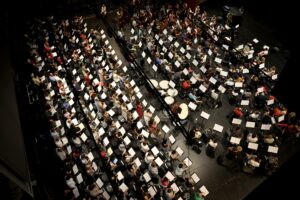from the correspondent in Verona – “Good morning. Let’s start with the fourth movement, thank you”. This is the one containing the Ode to Joy, the anthem of the European Union, a manifesto of unity and brotherhood from the 19th century to the present day. The journey behind the scenes of the Ninth Symphony by Ludwig van Beethoven on the 200th anniversary of its composition begins in the same way it will end a few days later at the Verona Arena. The words were spoken by conductor Andrea Battistoni, who led the Fondazione Arena di Verona Orchestra and Chorus on this musical journey “from hardship to the stars”, during the summer of the 101st Verona Opera Festival. Eunews was there to report on the whole event, from the rehearsals to the performance in the world’s most famous amphitheater, offering a fresh perspective on both the symphony by the Genius of Bonn and the most famous anthem in history.
The curtain of the general rehearsals for Beethoven’s Ninth Symphony, scheduled for Sunday, August 11, at the 2024 Arena Opera Festival, opens three days earlier. However, they do not take place in the Roman amphitheater but at the Philharmonic Theater, the city’s main opera house. The oppressive August heat in Verona during daylight hours makes it impossible for all professionals – from performers to technicians – to prepare the show outdoors and under the sun. The opportunity for final rehearsals at the Verona Arena will come in the late afternoon on Sunday, allowing time to adjust to the space and acoustics, which are entirely different from those of an indoor theater, just a few hours before the performance begins

The illuminated stage in the darkness of the Philharmonic Theater resembles any workplace: all chorus and orchestra artists clock in and out, with Beethoven’s notes bookended by the badge’s familiar double beep. Unlike the night of the performance, there is no standard uniform. Everyone arrives dressed as they please: some in shirts, some in sandals, some in Bermuda shorts, others in suits. What matters most is the meticulous work on the music. The 104 members of the Fondazione Arena di Verona Orchestra and the 158 members of the Fondazione Arena di Verona Chorus for the summer opera and symphony season must find harmony together after hours and hours of individual practice. Something that seems almost impossibile to achieve. First, the orchestra rehearses, then the chorus, and the four solo performers. Finally, the orchestra, chorus, and soloists come together.
It begins on Thursday with orchestra rehearsals. For two hours, the theater resounds with the music of the instruments and the voice of conductor Battistoni, who leads the orchestra and emphasizes the need for improvements in some of the most critical points of the fourth movement. To untrained ears, they seem like subtleties, but the meticulous work on ties, syncopations, downbeats and upbeats will be crucial for blending the music with the voices of the chorus. Rehearsals continue the next day with the soloists – US soprano Erin Morley, mezzo-soprano Anna Maria Chiuri, Russian bass Alexander Vinogradov, and tenor Ivan Magrì – and the conductor, who focuses on refining the nuances of the four voices, considering the orchestra’s entrances and exits. That same afternoon, chorus rehearsals are held under the guidance of chorus director Roberto Gabbiani, who is present on stage to oversee the adjustments required by conductor Battistoni in preparation for the crucial final rehearsal on the eve of the performance. On Saturday, all the artists gather on stage at the Philharmonic Theater for two hours to put the efforts of the previous days to the test, this time collectively, focusing on the most challenging passages that require further alignment between voices and instruments
Composed between 1822 and 1824, the Ninth Symphony represents a revolution in the symphonic genre due to Beethoven’s experimentation with themes, rhythms, and tonal colors, as well as its unprecedented scale and scope. The Genius of Bonn decided to introduce an extra-musical message, by incorporating Friedrich Schiller’s Ode to Joy (written in the summer of 1785), setting it to music in German for four soloists (soprano, mezzo-soprano, tenor and bass) and the chorus. The Ninth Symphony, also known as the Choral Symphony, is divided into four movements: three purely symphonic, followed by a fourth that includes the chorus. Conductor Battistoni and chorus director Gabbiani, who led the work on the Ninth Symphony at the Verona Arena, explain the main features of this symphonic masterpiece:
It was 1824 when Beethoven, already famous and almost completely deaf, presented his final symphony to the public. Two hundred years later, the fascination and admiration for this work remain undiminished, intertwined with the special connection the Ninth Symphony has with the world’s most famous amphitheater. This was the first symphony ever performed at the Arena di Verona, in 1927, and it has been repeated five times over nearly a century, most recently in 2021 as a tribute to the memory of conductor Ezio Bosso, before this year’s performance in honor of the exceptional anniversary. “With the artistic ensembles of the Fondazione Arena, which are also greatly expanding in the more demanding symphonic repertoire, we could not miss the 200th anniversary of the Ninth Symphony“, Cecilia Gasdia, superintendent of the Fondazione Arena di Verona: “Today, more than ever, we need to share this music and especially these words, hoping that their meaning will resonate throughout the world thanks to the internationality of the Arena audience“. This hope is shared by all the performers, from the conductors to the soloists and members of the choir and orchestra:
One of the most unmistakable and world-famous features of Beethoven’s Ninth Symphony is undoubtedly the Ode to Joy, the Genius of Bonn’s setting of the eponymous Ode (in German, An die Freude) contained in the fourth movement. This text, composed in the summer of 1785 and published the following year by the German poet and playwright Friedrich Schiller (with a slightly revised version in 1808), describes the Romantic ideal of a society united by universal joy and friendship. Beethoven’s first draft to set Schiller’s Ode to music dates back to 1799. It was finally completed 25 years later with the composition of the Ninth Symphony, which included the addition of three opening lines: “Oh friends, not these sounds! / Let us instead strike up more pleasing / and more joyful ones!” In this context, joy is not merely lightheartedness and cheerfulness, but the result of a gradual liberation from evil, hatred, and wickedness. The composition made music history and has entered the world’s collective imagination through numerous tributes across art, politics, and cinema.
Undoubtedly, what has made this composition even more famous and immortal is its association with the project of a united Europe. It was precisely because of its universal message of unity and brotherhood that the Ode to Joy became the European anthem. In 1972, the theme of the finale, re-arranged by Herbert von Karajan, was adopted by the Council of Europe and, by decision of the Heads of State. By decision of the Heads of State and Government of the Member States, it became the official anthem of the European Union in 1985. Since then, the Ode to Joy has been performed at official EU ceremonies and all events with a European character. However, unlike the composition that closes the Ninth Symphony, the European anthem is wordless to avoid privileging any one language over others (German, in this case). “In the universal language of music, this anthem expresses the ideals of freedom, peace, and solidarity pursued by Europe”, the EU institutions explain, a sentiment echoed by the performers at the Verona Arena:
Everything finally culminates in the most anticipated moment: the night of the performance at the Verona Arena. Braving the sweltering heat that in mid-August offers no respite even in the late afternoon, all the artists and technicians move to the Roman amphitheater to re-test what they will present on the stage a few hours later. They face one of the most complex challenges: acoustics. The elliptical shape, the limestone, the angling of voices and instruments relative to the 44 rows of tiers, and the open structure all add to the complexity of the performance compared to the days of fine-tuning in an indoor theater. After about an hour and a half of settling in, rehearsing, and fine-tuning in front of an empty amphitheater (with the audience also being a significant acoustic factor), conductor Battistoni decides that the balance has been achieved. Everyone can then head to the dressing rooms to prepare, all dressed in black for the evening, except for the four solo performers: soprano Morley in a long aquamarine lace dress, mezzo-soprano Chiuri in a black dress with a bordeaux chemisier, and tenor Magrì and bass Vinogradov both in white shirts and tailcoats.
The audience slowly fills the Verona Arena. At an archway, the two professionals responsible for providing service information from the speakers (note that the announcements are not pre-recorded, as one might assume) remind attendees that the show is about to begin, that cell phones should be turned off, and that video recording is not permitted. The chorus enters, followed by the orchestra, and performers tune their instruments. A spotlight directed at the side of the stage illuminates the entrance of conductor Battistoni. Thunderous applause signals that the performance can begin. The first two movements of the Ninth Symphony progress swiftly, with several melodies resonating strongly. As the third movement begins, the soloists make their entrance, ready for the celebrated fourth movement. The four voices stand out against the rich vocal tapestry created by the chorus and the musical surge of the orchestra, expertly guided by the conductor’s baton. The Ode to Joy arrives with a power that matches the anticipation and meets all expectations. The performance concludes with a ten-minute standing ovation, honoring the work of hundreds of professionals and paying tribute to the Genius of Bonn, who gifted the world with the most famous anthem in history. The anthem of the European Union.
In closing this report, we extend our gratitude to all the artists, technicians, workers, the press office of the Fondazione Arena di Verona which accommodated Eunews‘ request, and all the professionals who worked both on stage and behind the scenes to make the Arena Opera Festival possible for 101 years. We would like to echo baritone Alessandro Andreoli’s call to make the European anthem even more truly European. More accessible, understandable, and within the reach of all EU citizens,regardless of their region, country, or language. This is for the creation of a more solid and shared common identity. Europe, like you have never read it, the Ode to Joy as you have never listened to and sung it:
English version by the Translation Service of Withub






























![Modello della centrale nucleare di Akkuyu, in Turchia [foto: By Akkuyu Nükleer A.Ş. (VOA), Wikimedia Commons]](https://www.eunews.it/wp-content/uploads/2024/08/Akkuyu_Nuclear_Power_Plant-75x75.jpg)



![Un motoscafo in Svezia. Nell'Ue si pone un problema di mancato riconoscimento delle patenti nautiche [foto:
Matti Blume, Wikipedia Commons. Copyright: Creative Commons Attribution-Share Alike]](https://www.eunews.it/wp-content/uploads/2024/11/motoscafo-Saltsjoen_Stockholm_P1090679-120x86.jpg)
